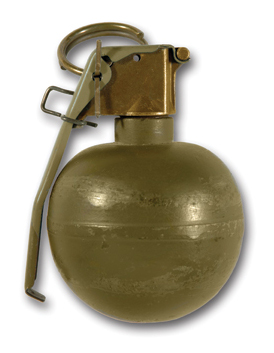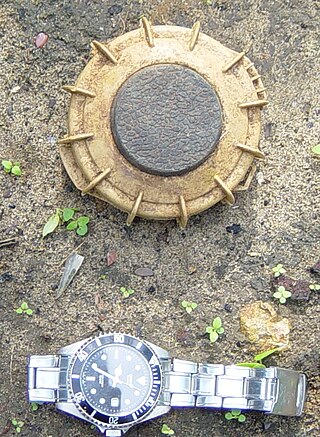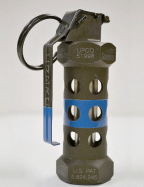
An explosive is a reactive substance that contains a great amount of potential energy that can produce an explosion if released suddenly, usually accompanied by the production of light, heat, sound, and pressure. An explosive charge is a measured quantity of explosive material, which may either be composed solely of one ingredient or be a mixture containing at least two substances.

A bomb is an explosive weapon that uses the exothermic reaction of an explosive material to provide an extremely sudden and violent release of energy. Detonations inflict damage principally through ground- and atmosphere-transmitted mechanical stress, the impact and penetration of pressure-driven projectiles, pressure damage, and explosion-generated effects. Bombs have been utilized since the 11th century starting in East Asia.

Non-lethal weapons, also called nonlethal weapons, less-lethal weapons, less-than-lethal weapons, non-deadly weapons, compliance weapons, or pain-inducing weapons are weapons intended to be less likely to kill a living target than conventional weapons such as knives and firearms with live ammunition. It is often understood that unintended or incidental casualties are risked wherever force is applied, however non-lethal weapons minimise the risk of casualties as much as possible. Non-lethal weapons are used in policing and combat situations to limit the escalation of conflict where employment of lethal force is prohibited or undesirable, where rules of engagement require minimum casualties, or where policy restricts the use of conventional force. However, these weapons occasionally cause serious injuries or death due to allergic reactions, improper use and/or other factors; for this reason the term "less-lethal" has been preferred by some organizations as it describes the risks of death more accurately than the term "non-lethal", which some have argued is a misnomer.

Flash powder is a pyrotechnic composition, a mixture of oxidizer and metallic fuel, which burns quickly (deflagrates) and produces a loud noise regardless of confinement. It is widely used in theatrical pyrotechnics and fireworks and was once used for flashes in photography.
Militarization, or militarisation, is the process by which a society organizes itself for military conflict and violence. It is related to militarism, which is an ideology that reflects the level of militarization of a state. The process of militarization involves many interrelated aspects that encompass all levels of society.

The M67 grenade is a fragmentation hand grenade used by the United States military. The M67 is a further development of the M33 grenade, itself a replacement for the M26-series grenades used during the Korean and Vietnam Wars, and the older Mk 2 "pineapple" grenade used since World War I.

The Mk 2 grenade, also nicknamed the Pineapple is a fragmentation-type anti-personnel hand grenade introduced by the U.S. armed forces in 1918. It was the standard issue anti-personnel grenade used during World War II, and also saw limited service in later conflicts, including the Korean War and Vietnam War. Replacing the failed Mk 1 grenade of 1917, it was standardized in 1920 as the Mk II, and redesignated the Mk 2 on April 2, 1945.
The military of the United States has used many different types of hand grenades since its foundation.

A dazzler is a non-lethal weapon which uses intense directed radiation to temporarily disorient its target with flash blindness. They can effectively deter further advances, regardless of language or cultural barriers, but can also be used for hailing and warning. Targets can include electronic sensors as well as human vision.

The United States Armed Forces has created a plethora of different types of 40 mm grenades in both the low-velocity 40×46 mm and high-velocity 40×53 mm calibers which uses what it calls a high-low propulsion system which keeps recoil forces within the boundaries of an infantry weapon. Presented on this page is a basic overview.

An anti-personnel mine or anti-personnel landmine (APL) is a form of mine designed for use against humans, as opposed to an anti-tank mine, which target vehicles. APLs are classified into: blast mines and fragmentation mines; the latter may or may not be a bounding mine.
Flash blindness is an either temporary or permanent visual impairment during and following exposure of a varying length of time to a light flash of extremely high intensity, such as a nuclear explosion, flash photograph, lightning strike, or extremely bright light, i.e. a searchlight, laser pointer, landing lights or ultraviolet light. The bright light overwhelms the retinas of the eyes and generally gradually fades, lasting anywhere from a few seconds to a few minutes. However, if the eyes are exposed to a high enough level of light, such as a nuclear explosion, the blindness can become permanent.

The M84 is the currently-issued stun grenade ("flashbang") of the United States Armed Forces and SWAT teams throughout the United States. Upon detonation, it emits an intensely loud "bang" of 170–180 decibels and a blinding flash of more than one million candelas within 5 feet of initiation, sufficient to cause immediate flash blindness, deafness, tinnitus, and inner ear disturbance. Exposed personnel experience disorientation, confusion and loss of coordination and balance. While these effects are all intended to be temporary, there is risk of permanent injury. Consequently, the M84 is classified as a less-lethal weapon.

Fragmentation is the process by which the casing, shot, or other components of an anti-personnel weapon, bomb, barrel bomb, land mine, IED, artillery, mortar, tank gun, or autocannon shell, rocket, missile, grenade, etc. are dispersed and/or shattered by the detonation of the explosive filler.

The F1 grenade is manufactured by Thales Australia exclusively for the Australian Defence Force as a primary defensive anti-personnel hand grenade.
The Plasma Acoustic Shield System, or PASS, is in the process of being developed by Stellar Photonics. The company received a $2.7 million contract from the U.S. Government to build the PASS. It is part of a project supervised by the United States Army Armament Research, Development and Engineering Center. The laser was first tested in 2008, and will continue to be tested into 2009, with the testing of turret-mounted PASS.

A grenade is an explosive weapon typically thrown by hand, but can also refer to a shell shot from the muzzle of a rifle or a grenade launcher. A modern hand grenade generally consists of an explosive charge ("filler"), a detonator mechanism, an internal striker to trigger the detonator, an arming safety secured by a transport safety. The user removes the transport safety before throwing, and once the grenade leaves the hand the arming safety gets released, allowing the striker to trigger a primer that ignites a fuze, which burns down to the detonator and explodes the main charge.

A blast ball, also known as a tear gas ball, rubber ball grenade, or stinger grenade, is a ball-shaped, rubber coated, less-lethal grenade designed for law enforcement and riot control applications. A blast ball is similar to a stun grenade in that, when detonated, it generates a loud noise and bright light; however, it also releases a chemical irritant and occasionally also rubber pellets or fragments.

The NICO BTV-1 flash-bang grenade is a flash-bang grenade used in the United States.















